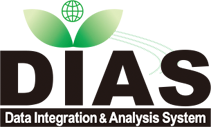Status of the DIAS Data Archive
Various information is necessary to solve environmental issues, including global-scale observation data; reanalysis data; local observation data for down-scaling and the construction of advanced models; urban building, vegetation distribution, soil and other surface cover information; and sewage network information. The CMIP3 and CMIP5 are also essential for long-term forecasts. In addition, it is necessary for stakeholders to provide the data involved in problem resolution, such as statistics on the outbreak of disasters and health hazards, and crop yields, fishing hauls, and other production statistics.
DIAS archives such kinds of data according to the priority of the associated project. In areas such as Asia and Africa where support is needed for data archiving, DIAS provides an integrated support portal for metadata creation, quality management, and data input. Meanwhile, data easily available to specialists is not necessarily archived in DIAS.
Moving forward, the data created in each associated project for the purpose of building advanced models is scheduled to be sequentially archived in DIAS, and open data from various ministries is expected to increase through coordination with government agencies.
Promotion of Earth Observations in Japan
In the last five years of the GEOSS 10-year Implementation Plan (2005-2015), it has been necessary to accelerate the integration of the global observation systems in Japan. To this end, it was decided to centrally register and publish metadata files including public URLs for data and observation items on the Ministry of Education, Culture, Sports, Science and Technology (MEXT) Earth observation portal site with the aim of releasing and sharing observation data for the Action Plan for Japanese Earth Observations.
When an institution implementing an Earth observation project creates a metadata file, the properties of the data accumulated and stored in the project are scrutinized and, in principle, the DIAS metadata creation support tool is used to create the metadata in order to promote the unification of metadata formats and the integrated application of data. Registration is been carried out for 155 projects so far. Current as of January 2015, 110 data sets are subject to metadata registration, of which registration work has been completed for 78 sets.
Also, in the case metadata is released for the target datasets of the project, the metadata is downloaded and processed sequentially to make it retrievable by the Search and Discovery System for DIAS Datasets. This year, approximately 60,000 files from the Geospatial Information Authority of Japan were added to the 2,300 metadata files obtained by 2013. In July 2014, further investigations were conducted concerning methods of data release. The results identified 19 projects for data registration in Data Integration and Analysis System, 51 projects for external release, 3 projects for non-release, and 5 other projects. Moving forward, the data for 19 projects is planned to be acquired from the data providers and released.
For the datasets available in DIAS, please refer to the Datasets page.



